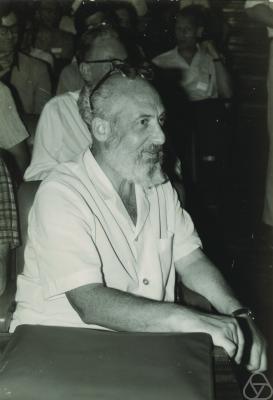Related Research Articles

Algebraic topology is a branch of mathematics that uses tools from abstract algebra to study topological spaces. The basic goal is to find algebraic invariants that classify topological spaces up to homeomorphism, though usually most classify up to homotopy equivalence.

Samuel Eilenberg was a Polish-American mathematician who co-founded category theory and homological algebra.
Daniel Gray Quillen was an American mathematician. He is known for being the "prime architect" of higher algebraic K-theory, for which he was awarded the Cole Prize in 1975 and the Fields Medal in 1978.
In mathematics, the Lyusternik–Schnirelmann category of a topological space is the homotopy invariant defined to be the smallest integer number such that there is an open covering of with the property that each inclusion map is nullhomotopic. For example, if is a sphere, this takes the value two.

Ralph Hartzler Fox was an American mathematician. As a professor at Princeton University, he taught and advised many of the contributors to the Golden Age of differential topology, and he played an important role in the modernization of knot theory and of bringing it into the mainstream.
The Novikov conjecture is one of the most important unsolved problems in topology. It is named for Sergei Novikov who originally posed the conjecture in 1965.
In mathematics, the J-homomorphism is a mapping from the homotopy groups of the special orthogonal groups to the homotopy groups of spheres. It was defined by George W. Whitehead, extending a construction of Heinz Hopf.
In mathematics, specifically geometric topology, the Borel conjecture asserts that an aspherical closed manifold is determined by its fundamental group, up to homeomorphism. It is a rigidity conjecture, asserting that a weak, algebraic notion of equivalence should imply a stronger, topological notion.

Dennis Parnell Sullivan is an American mathematician known for his work in algebraic topology, geometric topology, and dynamical systems. He holds the Albert Einstein Chair at the Graduate Center of the City University of New York and is a distinguished professor at Stony Brook University.
Ganea's conjecture is a now disproved claim in algebraic topology. It states that
The Eilenberg–Ganea conjecture is a claim in algebraic topology. It was formulated by Samuel Eilenberg and Tudor Ganea in 1957, in a short, but influential paper. It states that if a group G has cohomological dimension 2, then it has a 2-dimensional Eilenberg–MacLane space . For n different from 2, a group G of cohomological dimension n has an n-dimensional Eilenberg–MacLane space. It is also known that a group of cohomological dimension 2 has a 3-dimensional Eilenberg−MacLane space.
The Whitehead conjecture is a claim in algebraic topology. It was formulated by J. H. C. Whitehead in 1941. It states that every connected subcomplex of a two-dimensional aspherical CW complex is aspherical.

Simion Stoilow or Stoilov was a Romanian mathematician, creator of the Romanian school of complex analysis, and author of over 100 publications.
Ganea may refer to:
In algebraic topology, the doomsday conjecture was a conjecture about Ext groups over the Steenrod algebra made by Joel Cohen, named by Michael Barratt, published by Milgram and disproved by Mahowald (1977). Minami (1995) stated a modified version called the new doomsday conjecture.
In mathematics, the notion of externology in a topological space X generalizes the basic properties of the family
In mathematics, particularly in homological algebra and algebraic topology, the Eilenberg–Ganea theorem states for every finitely generated group G with certain conditions on its cohomological dimension, one can construct an aspherical CW complex X of dimension n whose fundamental group is G. The theorem is named after Polish mathematician Samuel Eilenberg and Romanian mathematician Tudor Ganea. The theorem was first published in a short paper in 1957 in the Annals of Mathematics.
Franklin Paul Peterson (1930–2000) was an American mathematician specializing in algebraic topology. He was a professor of mathematics at the Massachusetts Institute of Technology.

Dan Burghelea is a Romanian-American mathematician, academic, and researcher. He is an Emeritus Professor of Mathematics at Ohio State University.
References
- ↑ Biographical information
- 1 2 Cistelecan, Alexandru (May 26, 2006). "Iritarea la români". Bucureștiul Cultural, nr. 7/2006 (in Romanian). Revista 22 . Retrieved May 3, 2020.
- 1 2 3 Mardešić, Sibe (2000), "Topology in Eastern Europe 1900–1950" (PDF), Topology Proceedings, 25 (Spring): 397–430, MR 1875605
- ↑ Israel Berstein, June 23, 1926—September 22, 1991
- ↑ Ganea, Tudor (1962), Sur quelques invariants numeriques du type d'homotopie (in French), Paris, France: Faculté des sciences de Paris, OCLC 1672078
- ↑ Hilton, Peter J., ed. (1971). Symposium on Algebraic Topology. Battelle Seattle Research Center, Seattle, Wash., 22–26 February 1971. Dedicated to the memory of Tudor Ganea (1922–1971) (PDF). Lecture Notes in Mathematics. Vol. 249. Berlin-New York: Springer-Verlag. doi:10.1007/BFb0060889. ISBN 978-3-540-05715-4. MR 0328907.
- ↑ Hess, Kathryn P. (1991). "A proof of Ganea's conjecture for rational spaces". Topology . 30 (2): 205–214. doi: 10.1016/0040-9383(91)90006-p . MR 1098914.
- ↑ Iwase, Norio (1998). "Ganea's conjecture on Lusternik–Schnirelmann category". Bulletin of the London Mathematical Society . 30 (6): 623–634. CiteSeerX 10.1.1.509.2343 . doi:10.1112/S0024609398004548. MR 1642747. S2CID 6881044.
- ↑ Stanley, Donald; Rodríguez Ordóñez, Hugo (2010). "A minimum dimensional counterexample to Ganea's conjecture". Topology and Its Applications . 157 (14): 2304–2315. doi: 10.1016/j.topol.2010.06.009 . MR 2670507.